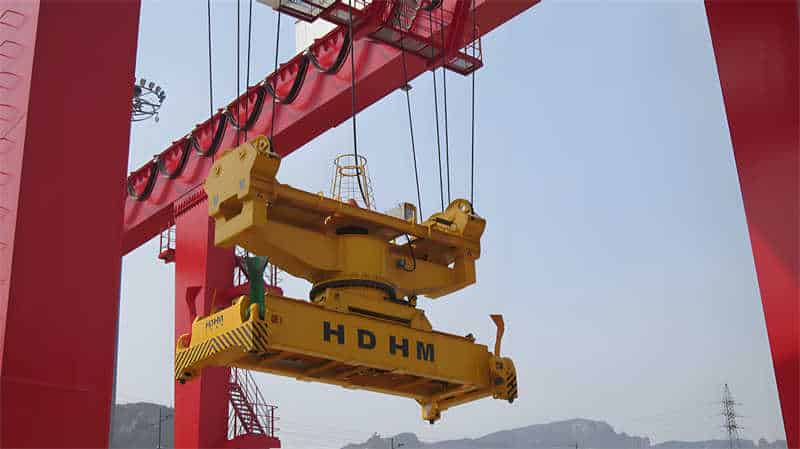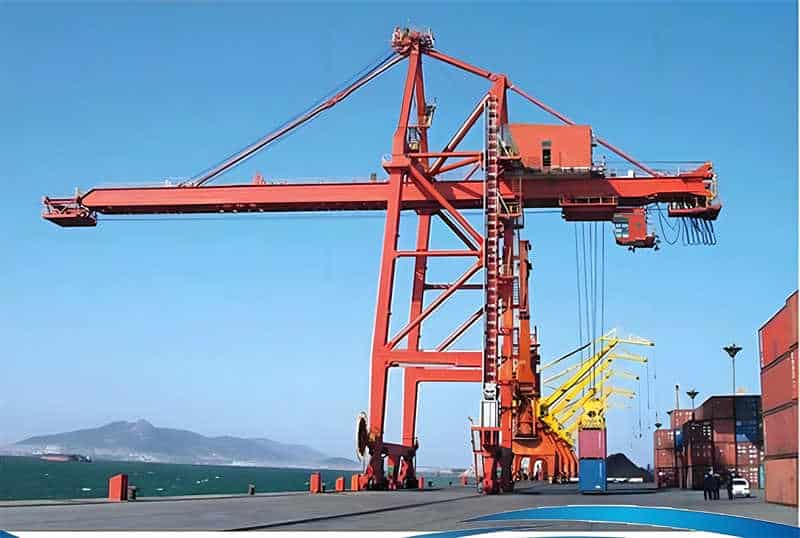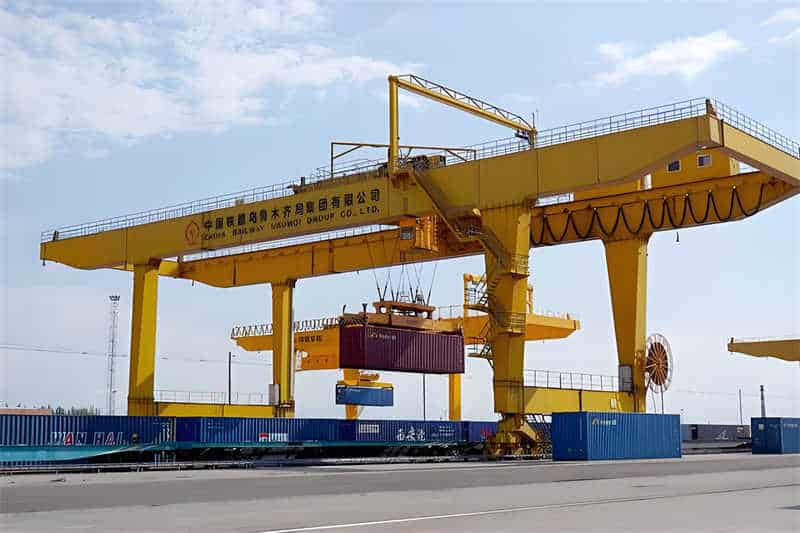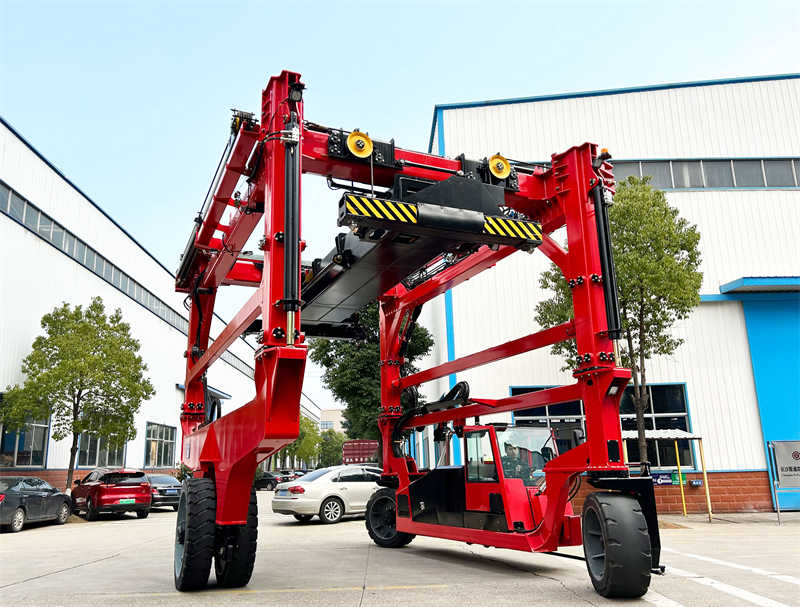This article is a detailed introduction to specialized machinery for container loading and unloading, mainly including five aspects: container lifting equipment, quay cranes, container gantry cranes, container reach stackers, and other container loading and unloading machinery.
Container lifting equipment is an important tool used for loading and unloading containers, mainly divided into two types: fixed lifting equipment and telescopic lifting equipment. Fixed lifting equipment is usually used for loading and unloading standard containers of 20 feet or 40 feet, while telescopic lifting equipment has greater flexibility and can adapt to containers of different lengths.
Fixed lifting equipment mainly consists of a hanger, lifting equipment body, guiding mechanism, rotating locking mechanism, and control system. A hanger is a supporting structure for lifting equipment, used to connect cranes. The main body of the lifting device is the main load-bearing component of the container, usually made of high-strength steel. The guiding mechanism ensures accurate positioning of the lifting device in the horizontal direction, while the rotating locking mechanism is used to lock and release the container.
The telescopic lifting device is even more complex, as it includes a telescopic mechanism that allows the lifting device to be adjusted in the length direction. This type of lifting device is commonly used for shore cranes to accommodate containers of different sizes.

The installation and debugging of lifting equipment are key steps to ensure its normal operation. During the installation process, it is necessary to ensure that all components of the lifting device are correctly installed and securely connected. This includes the connection between the hanger and the crane, as well as the connection between the main body of the hanger and the hanger.
During the debugging phase, it is necessary to debug the guiding mechanism, rotating locking mechanism, etc. of the lifting device to ensure their normal operation. During the debugging process, it is necessary to conduct multiple empty and full load tests on the lifting equipment to check its stability and reliability.
When using lifting equipment, it is necessary to strictly follow the operating procedures to avoid dangerous operations such as overloading and overspeed. At the same time, it is necessary to regularly inspect and maintain the lifting equipment, including checking whether the various components of the lifting equipment are intact, whether the connections are firm, and whether the lubrication is sufficient.
In addition, for telescopic lifting equipment, special attention should be paid to the wear and tear of its telescopic mechanism, and components with severe wear should be replaced in a timely manner. During the maintenance process, it is also necessary to perform regular maintenance on the lifting equipment, including cleaning, lubrication, fastening, etc., to extend its service life.
Shore container crane (abbreviated as quay crane) is one of the core equipment in the container terminal. Its structure is complex and mainly consists of metal structure, lifting mechanism, trolley running mechanism, trolley travel mechanism, electrical system and driver’s cab.
The metal structure is the main part of the quay crane, including columns, beams, booms, etc. The lifting mechanism is used to lift the container and is usually equipped with a winch and wire rope. The trolley running mechanism is responsible for moving left and right on the boom to achieve precise positioning of the container. The trolley travel mechanism enables the quay crane to move forward and backward on the track at the front of the terminal.
The working principle of the quay crane is to control the movement of each mechanism through the electrical system to realize the loading and unloading of containers. During the loading and unloading process, the lifting mechanism lifts the container, and the trolley running mechanism and trolley travel mechanism are responsible for transporting the container to the designated location.

The installation and commissioning of the quay crane is a complex and delicate task. During the installation process, it is necessary to ensure that each component is correctly installed and firmly connected. This includes the connection between the column and the foundation, the connection between the beam and the column, the connection between the arm and the beam, etc.
During the debugging stage, each mechanism needs to be debugged to ensure that it can work normally. This includes the lifting test of the lifting mechanism, the left and right movement test of the trolley running mechanism, and the forward and backward movement test of the trolley walking mechanism. At the same time, the electrical system needs to be debugged to ensure that it can accurately control the movement of each mechanism.
When using the quay crane, it is necessary to strictly abide by the operating procedures to avoid dangerous operations such as overloading and overspeeding. At the same time, it is also necessary to regularly inspect and maintain the quay crane, including checking whether the metal structure is intact, whether the connection is firm, and whether the lubrication is sufficient. For the electrical system, it is necessary to regularly check its working status to ensure accurate control and stable operation.
During the maintenance process, the quay crane also needs to be regularly maintained, including cleaning, lubrication, tightening, etc. For severely worn parts, they need to be replaced in time to ensure the stability and reliability of the quay crane.
Container gantry crane (referred to as gantry crane) is an important equipment on the container yard. Its structure mainly consists of metal structure, lifting mechanism, small car running mechanism, large car walking mechanism, and electrical system.
The metal structure is the main part of the gantry crane, including the main beam, support legs, crossbeams, etc. The lifting mechanism is used to lift containers and is usually equipped with a winch and steel wire rope. The small car operating mechanism is responsible for moving left and right on the main beam to achieve precise positioning of the container. The large vehicle traveling mechanism enables the gantry crane to move back and forth on the tracks in the yard.
The working principle of gantry cranes is similar to that of quay cranes, both of which control the movement of various mechanisms through electrical systems to achieve container loading and unloading operations. During the loading and unloading process, the lifting mechanism lifts the container, while the small car running mechanism and the large car traveling mechanism are responsible for transporting the container to the designated location.

The installation and commissioning of gantry cranes is also a complex and delicate task. During the installation process, it is necessary to ensure that all components are correctly installed and securely connected. This includes the connection between the main beam and the support legs, as well as the connection between the crossbeam and the main beam.
During the debugging phase, it is necessary to debug each mechanism to ensure its proper functioning. This includes the lifting test of the lifting mechanism, the left and right movement test of the small car running mechanism, and the front and rear movement test of the large car walking mechanism. At the same time, it is necessary to debug the electrical system to ensure that it can accurately control the movement of various mechanisms.
When using a gantry crane, it is also necessary to strictly follow the operating procedures to avoid dangerous operations such as overloading and overspeed. At the same time, it is necessary to regularly inspect and maintain the gantry crane, including checking whether the metal structure is intact, whether the connections are firm, and whether the lubrication is sufficient. For electrical systems, it is necessary to regularly check their working status to ensure accurate control and stable operation.
During the maintenance process, it is also necessary to perform regular maintenance on the gantry crane, including cleaning, lubrication, fastening, etc. For components with severe wear and tear, they need to be replaced in a timely manner to ensure the stability and reliability of the gantry crane.
Container reach stacker (referred to as reach stacker) is a tire crane with a telescopic boom, which is mainly used for loading and unloading, stacking and horizontal transportation operations in container yards. Its structure is mainly composed of metal structure, power unit, transmission system, control system, working device and outriggers.
The metal structure is the main part of the reach stacker, including the frame, boom, telescopic arm, etc. The power unit is usually a diesel engine, which provides power for the entire equipment. The transmission system is responsible for transmitting power to each working mechanism. The control system is used to control the movement and working state of the equipment. The working device includes a lifting mechanism, a telescopic mechanism, a rotating mechanism, etc., which are used to realize the loading and unloading of containers.
The working principle of the reach stacker is to control the movement of each mechanism through the control system to realize the loading and unloading of containers. During the loading and unloading process, the lifting mechanism lifts the container, and the telescopic mechanism and the rotating mechanism are responsible for transporting the container to the designated location.
The installation and commissioning of the reach stacker is relatively simple, but it is still necessary to ensure that each component is correctly installed and firmly connected. During the installation process, special attention should be paid to the connection between the frame and the outrigger, the connection between the arm and the frame, etc.
During the debugging stage, each mechanism needs to be debugged to ensure that it can work normally. This includes the lifting test of the lifting mechanism, the telescopic test of the telescopic mechanism, the rotation test of the rotating mechanism, etc. At the same time, the control system needs to be debugged to ensure that it can accurately control the movement of each mechanism.
When using the reach stacker, it is necessary to strictly abide by the operating procedures to avoid dangerous operations such as overloading and overspeeding. At the same time, it is necessary to regularly inspect and maintain the reach stacker, including checking whether the metal structure is intact, whether the connection is firm, and whether the lubrication is sufficient. For the power unit and transmission system, it is necessary to regularly check its working status to ensure smooth power transmission and stable operation.
During the maintenance process, the reach stacker also needs to be regularly maintained, including cleaning, lubrication, tightening, etc. For severely worn parts, they need to be replaced in time to ensure the stability and reliability of the front crane. At the same time, special attention should be paid to the wear of the tires, and severely worn tires should be replaced in time to ensure the driving safety of the equipment.
In addition to the above-mentioned quay cranes, gantry cranes and reach cranes, container terminals and yards are also equipped with a variety of other loading and unloading machinery, such as container forklifts, straddle carriers, container loading and unloading bridges, etc.
Container forklifts are a type of mechanical equipment used for short-distance transportation and stacking of containers. Its structure is mainly composed of a frame, a power system, a transmission system, a control system, and a fork. A straddle carrier is a type of loading and unloading machinery with a telescopic arm and a tire-type walking mechanism, which is mainly used for loading and unloading and horizontal transportation operations in container yards. A container loading and unloading bridge is a type of mechanical equipment used for loading and unloading containers between ships and terminals. Its structure and working principle are similar to those of quay cranes, but on a smaller scale.

When using these loading and unloading machinery, it is also necessary to strictly abide by the operating procedures to avoid dangerous operations such as overloading and speeding. At the same time, it is also necessary to regularly inspect and maintain the equipment, including checking whether the metal structure is intact, whether the connection is firm, and whether the lubrication is sufficient. For the power system and transmission system, it is necessary to check their working status regularly to ensure smooth power transmission and stable operation.
During the maintenance process, the equipment also needs to be maintained regularly, including cleaning, lubrication, tightening, etc. For severely worn parts, they need to be replaced in time to ensure the stability and reliability of the equipment. At the same time, special attention should be paid to the wear of walking parts such as tires and tracks, and severely worn parts should be replaced in time to ensure the driving safety of the equipment.
In summary, container loading and unloading machinery plays an irreplaceable core role in the container transportation system. It is a bridge and link connecting various modes of transportation such as ports, docks, railways, and roads, and is a key link in achieving efficient operation of the global logistics network. Only through scientific and reasonable use strategies and rigorous and meticulous maintenance systems can these equipment always maintain the best working condition and achieve long-term stable and efficient operation. In this regard, enterprises should attach importance to professional training for operators of container loading and unloading machinery, improve their skills, and ensure the proper use of equipment; establish a complete preventive maintenance plan, conduct regular inspections and timely repairs to effectively reduce the failure rate; formulate strict operating procedures and maintenance systems to ensure that the equipment is fully and properly cared for during operation. Only in this way can we provide strong guarantees for the sustained and healthy development of container transportation.
Contact our crane specialists
Send us a message and we will get back to you as soon as possible.